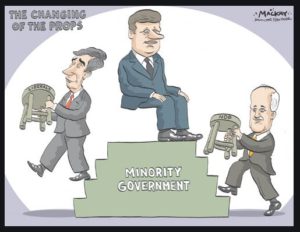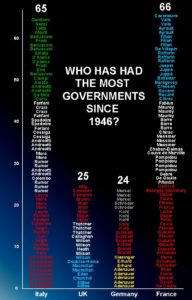The most straightforward form of government is a “majority” government. Majorities occur when a single party receives more than 50% of the seats. Minority and Coalition governments occur when a natural majority was not achieved, but what is the difference?
What is a Minority Government:
 A minority government is formed when the party that wins the most seats, but less than 50% of the total, informally agrees to work another party (or parties) on specific areas of agreement to archive more than 50% of the total. This other party is said to be “propping up” the government.
A minority government is formed when the party that wins the most seats, but less than 50% of the total, informally agrees to work another party (or parties) on specific areas of agreement to archive more than 50% of the total. This other party is said to be “propping up” the government.
For instance, if:
- “Party A” achieves 40% of the seats ,
- “Party B” archives 28% of the seats,
- “Party C” achieves 21% of the seats
- “Party D” archives 11% of the seats
“Party A” needs the support of any of the other parties to pass it’s legislation.
In practice, what usually happens is the party that won the most seats, contacts the leadership of one another party and work out a list of items they can agree on. That list is often not a public document and may not be a document at all. It may simply be a verbal agreement to work on particular areas of legislation.
It is possible that a minority government, say “Party A” in the example, gets support from “Party C” on one particular issue, but support from a different party, say “Party D” on a different issue, but that is not common place.
Minority governments can be unstable and fail before their full term because the non-ruling parties can combine their votes to overrule the government. In our example Party B, C, and D have 60% of the votes. In many cases this would quickly lead to a “vote of non-confidence” in the minority government and trigger another general election.
What is a Coalition Government:
 A coalition government is formed by two or more parties that agree to join forces on all issues brought before the government and form an “Absolute Majority”. The parties have not merged, they have simply agreed to a formal understanding until the next general election.
A coalition government is formed by two or more parties that agree to join forces on all issues brought before the government and form an “Absolute Majority”. The parties have not merged, they have simply agreed to a formal understanding until the next general election.
In our example, Party B, C, and D have 60% of the votes so if they can find enough common ground, they could form the government.
In practice, coalition governments are often very weak because the parties can not agree on legislation, cabinet members or leader and there are frequently personality conflicts based on serious differences in core believes.
Coalitions enable more people get a voice, but often that voice is just yelling at someone else. Countries like Italy, France and Israel are famously unstable. Israel has had 5 elections in the previous 10 years and as you can see in the graphic to the right, since the end of World War II, Italy has had 65 governments.
However, the video below explains that coalitions can work and on average last 60% of their full term (typically about 2.25 years).
What is the Difference Between a Minority and Coalition Government:
In theory the difference between a Minority and Coalition government is the formality. Minorities form a lose affiliation with another party to govern, while Coalitions are formal arrangements.
In practice, the difference between a Minority and Coalition government is the number of parties involved:
- Minority governments are usually composed of two parties (with one very clear leading party)
- Coalition governments are usually composed of three or more parties
Can a Coalition Government Take Over a Minority Government:
If a minority government is formed but later one of the parties withdraws its support and tried to join a formal coalition of other parties, a vote of “non-confidence” in the government will take place. That will result in the government falling and a general election being triggered.
Who Decides That a Coalition or Minority Government Has Been Formed:
This varies from country to country but in Canada, the Queens represent who is called the Governor General, makes the decision.
Canada, by law, also allows the previous Prime Minister first try to form either a Minority or Coalition Government. So in our example, if “Party B” previously held a majority government and therefore their leader was the previous Prime Minister, the Governor General would allow them a short period of time to try and form a minority or coalition with the support of the other parties, even though “Party A” won the most seats in the election. The idea of this convention is to maintain stability as the previous Prime Minister and cabinet know much more about the inner workings of the current policies than do opposition parties.



0 Comments